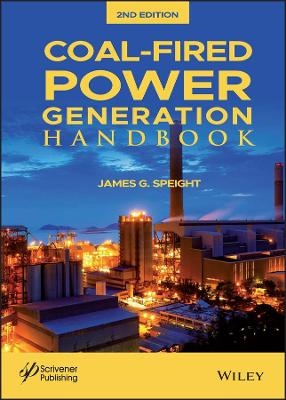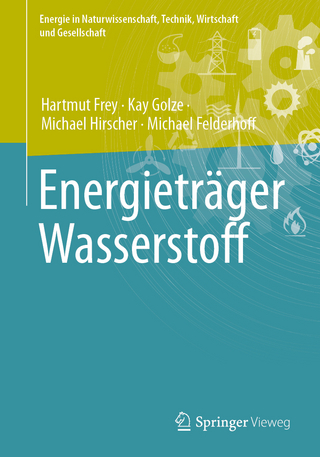
Coal-Fired Power Generation Handbook
Wiley-Scrivener (Verlag)
978-1-119-51010-9 (ISBN)
- Titel ist leider vergriffen;
keine Neuauflage - Artikel merken
This book describes the challenges and steps by which electricity is produced form coal and deals with the challenges for removing the environmental objections to the use of coal in future power plants. New technologies are described that could virtually eliminate the sulfur, nitrogen, and mercury pollutants that are released when coal is burned for electricity generation. In addition, technologies for the capture greenhouse gases emitted from coal-fired power plants are described and the means of preventing such emissions from contributing to global warming concerns.
Written by one of the world’s leading energy experts, this volume is a must-have for any engineer, scientist, or student working in this field, providing a valuable reference and guide in a quickly changing field.
James G. Speight, PhD, has more than forty-five years of experience in energy, environmental science, and ethics. He is the author of more than 65 books in petroleum science, petroleum engineering, biomass and biofuels, and environmental sciences. Although he has always worked in private industry which focused on contract-based work, Dr. Speight has served as Adjunct Professor in the Department of Chemical and Fuels Engineering at the University of Utah and in the Departments of Chemistry and Chemical and Petroleum Engineering at the University of Wyoming. In addition, he was a Visiting Professor in the College of Science, University of Mosul, Iraq , and has also been a Visiting Professor in Chemical Engineering at the University of Missouri-Columbia, the Technical University of Denmark, and the University of Trinidad and Tobago.
Preface xvii
Part I: Origin and Properties 1
1 History, Occurrence, and Resources 3
1.1 Introduction 3
1.2 Origin of Coal 8
1.3 Occurrence 12
1.4 Coal Utilization and Coal Types 14
1.5 Resources 22
1.6 Reserves 26
1.7 Energy Independence 31
References 33
2 Classification 37
2.1 Introduction 37
2.2 Nomenclature of Coal 39
2.3 Classification Systems 43
2.4 Coal Petrography 59
2.5 Correlation of the Various Systems 62
References 65
3 Recovery, Preparation, and Transportation 67
3.1 Introduction 67
3.2 Coal Recovery 69
3.3 Coal Preparation 78
3.4 Size Reduction 87
3.5 Coal Cleaning 92
3.6 Coal Drying 98
3.7 Desulfurization 104
3.8 Transportation 105
References 109
4 Storage 113
4.1 Introduction 113
4.2 Stockpiling 115
4.4 Spontaneous Ignition 124
4.5 Mechanism of Spontaneous Ignition 134
4.6 Preventing Spontaneous Ignition 137
References 138
5 General Properties 143
5.1 Introduction 143
5.2 Sampling 149
5.3 Proximate Analysis 154
5.4 Ultimate Analysis 167
5.5 Calorific Value 174
5.6 Reporting Coal Analyses 176
References 180
6 Physical, Mechanical, Thermal, and Electrical Properties 187
6.1 Introduction 187
6.2 Physical Properties 190
6.3 Mechanical Properties 200
6.4 Thermal Properties 207
6.5 Electrical Properties 214
6.6 Epilog 217
References 217
Part II: Power Generation 223
7 Combustion 225
7.1 Introduction 225
7.2 General Aspects 230
7.3 Chemistry and Physics 232
7.4 Catalytic Combustion 249
7.5 Fuels 249
References 269
8 Combustion Systems 275
8.1 Introduction 275
8.2 Combustion Systems 278
8.3 Fuel Feeders 303
References 304
9 Gasification 307
9.1 Introduction 307
9.2 General Aspects 309
9.3 Chemistry and Physics 325
9.4 Catalytic Gasification 334
9.5 Plasma Gasification 335
9.6 Gaseous Products 336
9.7 Underground Gasification 341
References 344
10 Gasification Systems 349
10.1 Introduction 349
10.2 Gasifier Types 352
10.3 Fixed-Bed Processes 358
10.4 Fluidized-Bed Processes 367
10.5 Entrained-Bed Processes 381
10.6 Molten Salt Processes 386
10.7 Other Designs 390
10.8 Gasifier-Feedstock Compatibility 396
10.8.7 Propensity for Char Formation 400
10.8.8 Mineral Matter Content 400
10.8.9 Ash Yield 400
10.9 Energy Balance and Other Design Options 401
10.10 Underground Gasification 402
References 406
11 Electric Power Generation 409
11.1 Introduction 409
11.2 Electricity From Coal 412
11.3 Steam Generation 415
11.4 Control of Emissions 425
11.5 Power Plant Efficiency 428
11.6 Combined Cycle Generation 432
References 435
12 Gas Cleaning 437
12.1 Introduction 437
12.2 General Aspects 437
12.3 Air Pollution Control Devices 445
12.4 Particulate Matter Removal 449
12.5 Acid Gas Removal 458
12.6 Removal of Sulfur-Containing Gases 462
12.7 Removal of Nitrogen-Containing Gases 465
12.8 Environmental Legislation 467
References 469
13 Clean Coal Technologies for Power Generation 473
13.1 Introduction 473
13.2 Historical Perspectives 480
13.3 Modern Perspectives 481
13.4 Clean Coal Technology 483
13.5 Managing Wastes from Coal Use 504
13.6 Carbon Dioxide Capture and Sequestration 506
References 514
14 Environmental Issues 519
14.1 Introduction 519
14.2 Coal Preparation 521
14.3 Transportation and Storage 523
14.4 Combustion 525
14.5 Gasification 532
14.6 Power Plant Waste 536
14.7 The Future 553
References 556
Part III: Alternative Feedstocks and Energy Security 559
15 Alternate Feedstocks 561
15.1 Introduction 561
15.2 Viscous Feedstocks 562
15.3 Biomass 575
15.4 Waste 605
References 610
16 Combustion of Alternate Feedstocks 613
16.1 Introduction 613
16.2 Viscous Feedstocks 615
16.3 Biomass 619
16.4 Solid Waste 632
References 638
17 Gasification of Alternate Feedstocks 641
17.1 Introduction 641
17.2 Viscous Feedstocks 643
17.3 Biomass 651
17.4 Solid Waste 656
17.5 Process Products 667
References 673
18 Coal and Energy Security 679
18.1 Introduction 679
18.2 Energy Security 683
18.3 The Future of Coal 687
18.4 Sustainable Development 694
References 701
Conversion Factors 705
Glossary 709
Index 753
About the Author 759
| Erscheinungsdatum | 16.03.2021 |
|---|---|
| Reihe/Serie | Power Generation |
| Sprache | englisch |
| Maße | 10 x 10 mm |
| Gewicht | 454 g |
| Themenwelt | Naturwissenschaften ► Chemie ► Technische Chemie |
| Technik ► Elektrotechnik / Energietechnik | |
| ISBN-10 | 1-119-51010-4 / 1119510104 |
| ISBN-13 | 978-1-119-51010-9 / 9781119510109 |
| Zustand | Neuware |
| Informationen gemäß Produktsicherheitsverordnung (GPSR) | |
| Haben Sie eine Frage zum Produkt? |
aus dem Bereich


